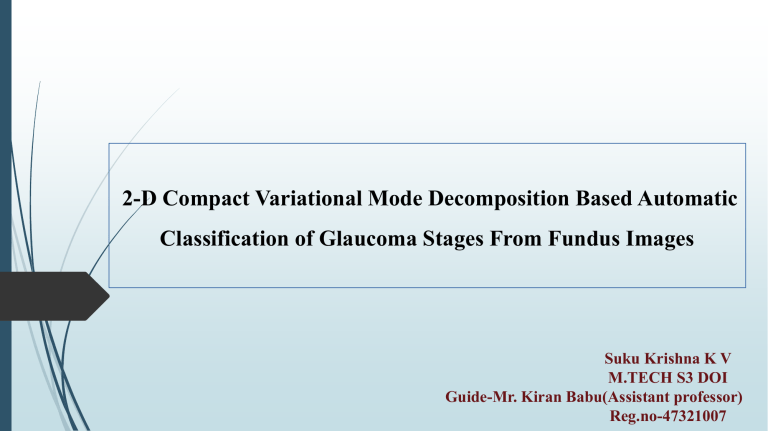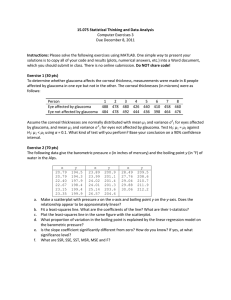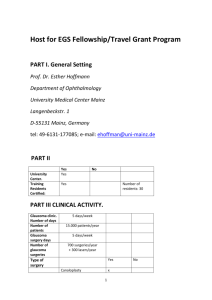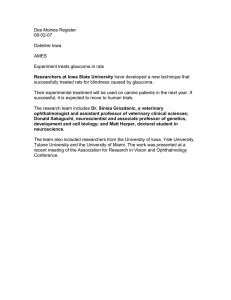
2-D Compact Variational Mode Decomposition Based Automatic Classification of Glaucoma Stages From Fundus Images Suku Krishna K V M.TECH S3 DOI Guide-Mr. Kiran Babu(Assistant professor) Reg.no-47321007 Index Abstract Introduction Literature review Existing Method Drawbacks Proposed method Advantages Applications Hardware and Software Requirement Conclusion References Abstract: Glaucoma is one of the leading causes of vision loss worldwide. This problem can be reduced by the early and reliable diagnosis of glaucoma. Here a method to classify the glaucoma stages (healthy, early-stage, and advanced stage) using a 2-D compact variational mode decomposition (2-D-C-VMD) algorithm is done. The preprocessed input images are first decomposed into several variational modes (VMs) employing 2-D-CVMD. Finally, a trained multiclass least-squares-support vector machine (MC-LS-SVM) classifier has been utilized for classification purpose. Introduction: Glaucoma is a group of eye diseases, which results in damage to the optic nerve. The main risk factor is increased intraocular pressure (IOP) in the eye. The disorders can be divided into two major groups, namely, primary open-angle glaucoma (POAG) and primary angle closer glaucoma (PACG). Glaucoma can permanently damage the vision of the affected eye because the effect of glaucoma is gradually increased, which is difficult to identify earlier until the circumstance is at a critical stage. It is necessary to have regular eye examinations so that diagnosis can be made in its early stages and treated appropriately. Literature Review: S. No Journal Type with year Authors Title Outcomes Studied about disc- IEEE Trans. Med. Imag., vol. 1 Disc-aware ensemble aware ensemble 37, no. 11, pp. 2493–2501, Nov. H. Fu et al. network for glaucoma network for 2018. screening from fundus image glaucoma screening. in Proc. 1st IEEE Int. Conf. Meas., Instrum., Control 2 Automated classification of Studied about glaucoma using retinal classification of fundus images glaucoma D. Parashar and D. Autom. (ICMICA), Agrawal Kurukshetra, India, Jun. 2020, pp. 1–6. Studied about IEEE Trans. Inf. Technol. 3 S. Dua, U. R. Acharya, P. Wavelet-based energy glaucomatous image Biomed., vol. 16, no. 1, pp. 80– Chowriappa, and S. V. Sree features for glaucomatous classification using 87, Jan. 2012 image classification wavelet Literature Review: S. No Journal Type with year Authors Title Outcomes Detecting glaucoma progression using A. T. Nguyen, D. S. Ophthalmology 4 guided progression analysis with OCT Greenfield, A. S. Glaucoma, vol. 2, no. 1, and visual field assessment in eyes Bhakta, J. Lee, and pp. 36–46, Jan. 2019. classified by international classification Studied about glaucoma stages progression W. J. Feuer of disease severity codes Med. Eng. Phys., vol. 34, 5 T.-C. Lim, S. A survey and comparative study on the no. 2, pp. 129–139, Mar. Chattopadhyay, and instruments for glaucoma detection 2012. U. R. Acharya Automated diagnosis of glaucoma using IEEE J. Biomed. Health 6 S. Maheshwari, R. B. empirical wavelet transform and Informat., vol. 21, no. 3, Pachori, and U. R. correntropy features extracted from pp. 803–813, May 2017. Acharya fundus images It’s a comparative study glaucoma detection Studied about empirical wavelet transform and other feature extracting methods for diagnosing glaucoma. Existing Method: Automated diagnosis of glaucoma using digital fundus images based on empirical wavelet transform (EWT). The EWT is used to decompose the image, and correntropy features are obtained from decomposed EWT components. These extracted features are ranked based on t value feature selection algorithm. Then, these features are used for the classification of normal and glaucoma images using least-squares support vector machine (LS-SVM) classifier. The LS-SVM is employed for classification with radial basis function, Morlet wavelet, and Mexican-hat wavelet kernels. Disadvantages in Existing Method: EMD approach having drawbacks such as • boundary distortion • noise sensitivity (Sn) • mode mixing • the lack of mathematical proof. Proposed Method: Block Diagram of Proposed Method Proposed Method: • Support Vector Machine(SVM) is a supervised machine learning algorithm used for both classification and regression. • The goal of the SVM algorithm is to create the best line or decision boundary that can segregate ndimensional space into classes so that it will easily put the new data point in the correct category in the future. This best decision boundary is called a hyperplane. • Least-squares support-vector machines (LS-SVM) are least-squares versions of support-vector machines (SVM). • Here one finds the solution by solving a set of linear equations instead of a convex quadratic programming (QP) problem for classical SVMs. Proposed Method: • Least-squares SVM classifiers were proposed by Johan Suykens and Joos Vandewalle. LS-SVMs are a class of kernel-based learning methods. • Green channel images have been extracted from the RBG image because it contains finer details for down-streaming analysis. • Further, Using contrast-limited histogram equalizations (CLAHE) to improve contrast and pixel intensity. Then, 2-D-C-VMD has been used for ID. • Then, various features are computed from the first variational mode (VM). • Then, linear discriminant analysis (LDA) has been applied for the reduction of dimensionality. • Afore, a trained multiclass least squares-support vector machine (MC-LS-SVM) classifier has been utilized for the classification task. Advantages of Proposed Method: SVM Classifier • SVM works relatively well when there is a clear margin of separation between classes. • SVM is more effective in high dimensional spaces. • SVM is effective in cases where the number of dimensions is greater than the number of samples. • SVM is relatively memory efficient • A prevalent and effective decomposition method is the variational mode decomposition (VMD). • Compared to EMD decomposition, VMD has excellent noise resistance, better decomposing performance, and stability and can be also utilized for feature extraction and fault diagnose Applications of Proposed Method: • In medical fields • In early stage of glaucoma Hardware & Software Requirements: Software: Matlab R2020a or above Hardware: Disk: Operating Systems: Minimum: 2.9 GB of HDD space for MATLAB only, 5-8 • Windows 10 GB for a typical installation • Windows 7 Service Pack 1 Recommended: An SSD is recommended A full installation • Windows Server 2019 of all MathWorks products may take up to 29 GB of disk • Windows Server 2016 space Processors: RAM: Minimum: Any Intel or AMD x86-64 processor Minimum: 4 GB Recommended: Any Intel or AMD x86-64 processor with four logical cores and AVX2 instruction set support Recommended: 8 GB Conclusion A newly introduced 2-D-C-VMD-based algorithm has been used for ID It has various advantageous properties such as sharp boundaries, fully adaptive, and non-recursive multiresolution technique. VMD has been employed to decompose preprocessed fundus images into different VMs. It will have less computation complexity with better Ac and speed. Effective for early and more accurate detection of glaucoma. References: [1] H. Fu et al., “Disc-aware ensemble network for glaucoma screening from fundus image,” IEEE Trans. Med. Imag., vol. 37, no. 11, pp. 2493–2501, Nov. 2018. [2] D. Parashar and D. Agrawal, “Automated classification of glaucoma using retinal fundus images,” in Proc. 1st IEEE Int. Conf. Meas., Instrum., Control Autom. (ICMICA), Kurukshetra, India, Jun. 2020, pp. 1–6. [3] S. Dua, U. R. Acharya, P. Chowriappa, and S. V. Sree, “Wavelet-based energy features for glaucomatous image classification,” IEEE Trans. Inf. Technol. Biomed., vol. 16, no. 1, pp. 80–87, Jan. 2012. References: [4] A. T. Nguyen, D. S. Greenfield, A. S. Bhakta, J. Lee, and W. J. Feuer, “Detecting glaucoma progression using guided progression analysis with OCT and visual field assessment in eyes classified by international classification of disease severity codes,” Ophthalmology Glaucoma, vol. 2, no. 1, pp. 36–46, Jan. 2019. [5] T.-C. Lim, S. Chattopadhyay, and U. R. Acharya, “A survey and comparative study on the instruments for glaucoma detection,” Med. Eng. Phys., vol. 34, no. 2, pp. 129–139, Mar. 2012. [6] S. Maheshwari, R. B. Pachori, and U. R. Acharya, “Automated diagnosis of glaucoma using empirical wavelet transform and correntropy features extracted from fundus images,” IEEE J. Biomed. Health Informat., vol. 21, no. 3, pp. 803–813, May 2017.





